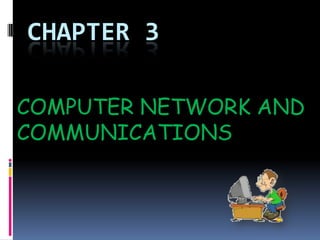
Bab3-computer network
- 1. CHAPTER 3 COMPUTER NETWORK AND COMMUNICATIONS
- 2. Basic concepts of computer networks and communications Define computer networks is a system of interconnected computers and peripheral devices. For example, it may connect computers, printers, scanners and cameras
- 3. Define computer communications is about the transfer of information from a sender, across a distance, to a receiver. Using electricity, radio waves or light, information and data in the form of codes are transmitted through a physical medium such as wire, cable, or even the atmosphere. The information that is transmitted (sent) can be text, voice, sound, video, graphics and images, or a combination of all these, which we call multimedia.
- 4. Online education The importance of computer E- E-business banking networks and communications Long Distance communications
- 5. Online education With a network connections, online education is made possible. Students at any location around the world can participate in an online classroom, download tutorial questions and submit their assignments. E-business Is refers to conducting business transactions on the internet, not only limited to buying and selling but also servicing customers and collaborating with business partners.
- 6. E-banking handles all types of banking transactions like account management, fund transfer and payments primarily over the internet. Long Distance communications is made easy via network availability. Communication is possible via voice, text or video.
- 7. Types of computer network Local Area network (LAN) Metropolitan Area Network (MAN) Wide Area Network (WAN)
- 8. Metropolitan Area Network (MAN) can be defined as a group of computers and network devices connected together within a large physical area. WANis the largest network of all network types. The Internet is the largest WAN in the world. WAN generally covers large distances such as states, countries or continents.
- 9. Local Area network (LAN) is a group of computers and network devices connected together, usually within the same building. It is the smallest network compared to the other two networks. The simplest form of LAN is to connect two computers together. Inexpensive hardware used in LAN previously include twisted pair, coaxial cables and the higher end is fiber optic or wireless
- 10. Wide Area Network (WAN) o WAN is a group of MANs or LANs or the mixture of both networks. o WANis the largest network of all network types. The Internet is the largest WAN in the world. o WAN generally covers large distances such as states, countries or continents. o A device called a router is needed to connect the MANs and LANs all over a large physical area. o A router is a special networking device that connects two or more different networks and keeps data flowing between them.
- 11. Types Network Architecture Client /Server Peer- to - peer
- 12. Client/server is a network in which the shared files and applications are stored in the server but network users (clients) can still store files on their individual PCs. Peer-to-peer a network with all the nodes acting as both servers and clients. A PC can access files located on another PC and can also provide files to other PCs.
- 13. 3 types of network topology Bus topology Ring topology Star topology
- 14. Bus topology consists of a single central cable to which all computers and other devices connect Ring topology consists of all computers and other devices that are connected in a loop Star topology consists of a central host which acts as the centre, and all nodes connect to the host.
- 15. Types of network communications technology internet extranet intranet
- 16. Internet is the worldwide, publicly accessible system of interconnected computer networks that transmit data by packet switching using the standard Internet Protocol (IP). Extranet is a private network that uses Internet protocols, network connectivity, and possibly the public telecommunication system to securely share part of a business’s information or operations with suppliers, vendors, partners, customers or other businesses. Intranet is an internal network that uses Internet technologies and it is a small version of the Internet that exists within an organisation.
- 17. Devices needed in computer communications network Network Wireless Modem interface Card Network (internal and (NIC) Interface Card external) Hub /switch Router
- 18. Functions Network interface Card (NIC) is an adapter card or PC card that enables the computer to access the network Wireless Network Interface Card is a network card that provides wireless data transmission Modem (internal and external) There are two types of modem, internal modem and external modem. An internal modem only works in stand-alone computers.
- 19. Hub /switch is a common connection point for devices in a network. Hubs are commonly used to connect segments of a LAN. Router is a communications device that connects multiple computers or other routers together and transmits data to the correct destination
- 20. Medium Types of Cables Unshielded Shielded Twisted Twisted Pair Pair (UTP) (STP) Fibre Optic Cable
